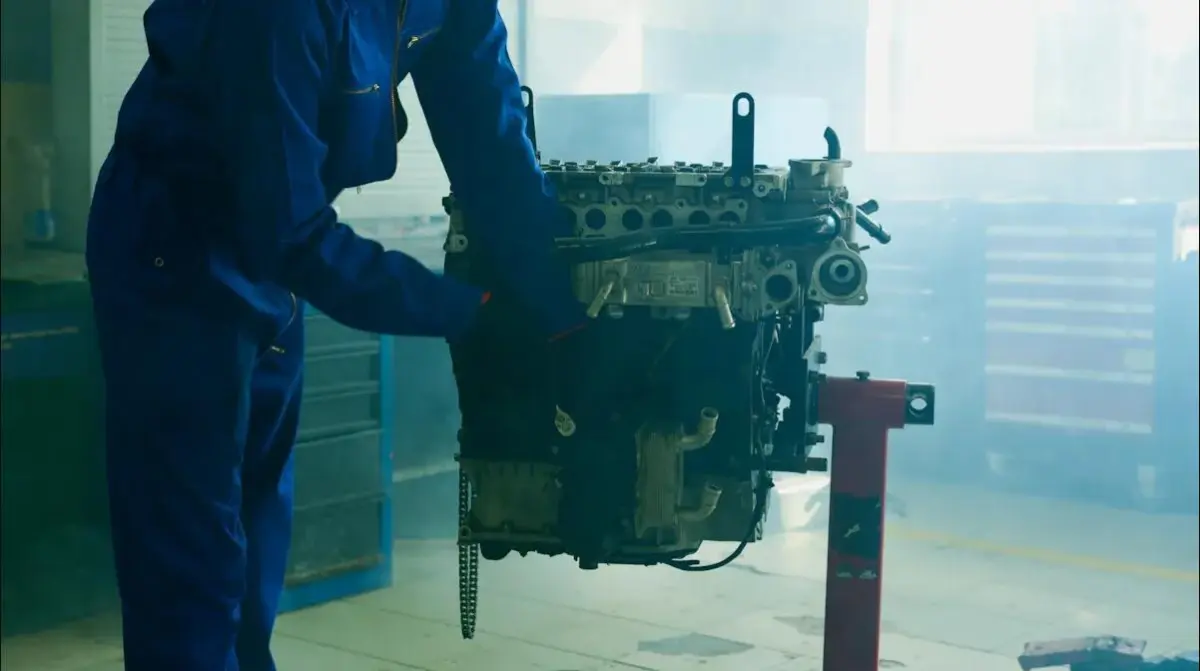
The car engine is like the heart of the human body. Keeping it in optimal condition is the key to ensuring the smooth operation of the vehicle. Timely detection of potential faults can not only save maintenance costs but also effectively extend the service life of the vehicle. Be vigilant when you find the following abnormal signs:
• Abnormally high temperature warning (reduced cooling system efficiency)
• Sudden increase in fuel consumption (may be accompanied by power attenuation)
• Metal friction noise (signal of wear of components such as pistons/crankshafts)
If the engine has already failed, please contact the maintenance personnel for repair in time, or consider purchasing an engine rebuild kit to rebuild the engine. You can rely on trusted engine parts suppliers such as Baileparts for help. Baileparts provides high-quality engine parts to help you restore the performance of your car and keep it in optimal running condition.
Key Takeaways
- Look for warning signs like lights on the dashboard or strange sounds. Fixing these early can save money on big repairs.
- Check engine fluids often, like oil and coolant. Keeping them full stops overheating and protects the engine.
- Use an OBD-II scanner to find engine problems fast. This tool shows issues and helps decide if repairs are needed soon.
- Check engine parts for damage or leaks. Regular checks find small issues before they become big problems.
- Know when to call a mechanic. A mechanic can fix problems safely if problems don’t go away or need special tools.
Recognizing Symptoms of Engine Problems

Warning Lights and Dashboard Indicators
Dashboard indicators are your first line of defense when it comes to identifying engine problems. The “check engine” light can mean small or big issues, like sensor errors or engine trouble. CarMD says that almost half of drivers have a warning light on. Ignoring these lights can cause expensive repairs or breakdowns.
When the “check engine” light flashes, act fast. Flashing often means a problem needing quick attention. Modern cars also have other lights, like oil pressure or coolant temperature warnings. These lights show your engine’s condition and help you fix problems early.
Unusual Noises and Vibrations
Strange noises or vibrations can mean engine trouble. Knocking, banging, or grinding sounds might mean piston or bearing problems. Vibrations while driving could come from the engine, driveline, or wheels. For example:
|
Source of Vibration |
What It Means for Your Car |
|---|---|
| Engine and engine accessories | Gear noise, worn parts, or gear-tooth problems |
| Driveline | Rattling gearbox, broken driveshaft, or discomfort |
| Wheels/Tires | Noise and shaking that affect driving |
Overheating and Temperature Spikes
An overheating engine is a big problem needing quick action. Overheating can cause major damage, like warped parts or coolant leaks. If the temperature gauge rises fast or steam comes out, stop driving and check it.
Overheating happens from low coolant, bad thermostats, or broken radiators. Checking coolant levels and flow often can stop these issues. Overheating hurts engine performance and safety, Fixing it quickly saves money on repairs.
Note: If your engine overheats a lot, see a mechanic. They can find and fix the main problem.
Reduced Fuel Efficiency and Power Loss
If your car suddenly uses more fuel, there’s likely a problem. Issues in the fuel system or engine parts can upset the air-fuel mix. This makes the engine burn fuel less efficiently. Common reasons for poor fuel efficiency include:
- Broken oxygen sensors give wrong information to the engine, wasting fuel.
- Dirty fuel injectors block fuel flow, making the engine use extra fuel.
- Old air filters stop airflow, lowering how well fuel burns.
You might also feel less powerful when speeding up or climbing hills. This happens when worn engine parts or fuel system problems hurt performance. Cleaning injectors and changing sensors can fix these issues.
Smoke, Smells, and Leaks
Smoke, strange smells, or leaks mean engine trouble. Different smoke colors show different problems:
| Type of Smoke | Possible Cause |
|---|---|
| Blue Smoke | Oil burning from worn piston rings or valve seals. |
| White Smoke | Coolant is leaking into the engine’s combustion area. |
| Black Smoke | Too much fuel is burning from a bad fuel injector. |
Bad smells, like burning rubber or gas, may mean overheating or leaks. Check your engine if you notice these odors. Leaking fluids, like oil or coolant, can cause big damage if ignored.
Note: Put cardboard under your car to spot leaks. This helps you figure out if the engine or another part is the problem.
Checking for smoke, smells, and leaks often keeps your engine healthy. Fixing these problems early avoids expensive repairs and keeps your car safe.
Step-by-Step Engine Diagnostic Process
Finding engine problems can seem hard, but a plan helps. By checking your car step by step, you can spot issues early. This saves money and avoids big repairs. Follow this guide to make the process easier.
Looking Over Engine Parts
Start by checking the engine and its parts. Look for cracks, rust, or loose pieces. Check belts, hoses, and seals for wear or damage. Look under the car for leaks or puddles. These might mean engine trouble.
Visual checks help find problems early. For example, rust on parts can lead to bigger issues. Regular checks keep your car running well and prevent sudden breakdowns. Always inspect your engine before long trips.
Tip: Use a flashlight to see hidden areas. This helps you find small problems.
Checking Oil, Coolant, and Fluids
Fluids are very important for your engine. Check oil, coolant, and other fluids often. Dirty or low oil can damage engine parts. Not enough coolant can cause overheating. Low brake or transmission fluid can make driving unsafe.
Here’s why fluid checks are important:
- They keep your car safe and running smoothly.
- They save fuel and lower costs over time.
- They help your car last longer and keep its value.
Park on a flat surface and let the engine cool. Use the dipstick to check oil levels and color. Look at the coolant tank for proper levels and color. Do the same for brake and transmission fluids.
Note: If fluids look strange or levels are off, ask a mechanic or supplier for help.
Using Tools Like OBD-II Scanners
Modern cars have systems to find problems easily. An OBD-II scanner reads codes from your car’s computer. These codes tell you what’s wrong with the engine.
Using an OBD-II scanner is simple. Plug it into the port under the dashboard. Follow the steps to get error codes. Each code shows a specific problem, like a bad sensor. Look up the codes or ask a pro for advice.
This tool saves time and money by finding problems fast. It also helps you know if a repair is urgent or can wait. For example, a small sensor issue might not need fixing right away. But a flashing “check engine” light needs quick action.
Inspecting Electrical Components and Connections
Electrical parts are important for your engine to work well. Bad connections or broken parts can stop electricity flow, causing engine problems. Checking these parts keeps your car running smoothly and avoids sudden breakdowns.
Start by looking at the parts closely. Check for loose ends, rusty terminals, or burnt connectors. Focus on the battery cables and alternator connections, as these often have issues. Use a flashlight to find hidden damage or wear.
Then, test the systems to make sure they work. Use special tools to check key electrical systems. For example, test the alternator to see if it charges the battery properly. Look at the starter motor for signs of damage or failure. Testing helps find problems you can’t see by just looking.
Tip: Disconnect the battery before checking electrical parts. This stops short circuits.
Carefully checking electrical parts can save you from expensive repairs. Fixing small problems early stops them from becoming big ones. If you need new parts, get them from a trusted supplier to ensure they fit and work well.
Testing the Battery and Ignition System
The battery and ignition system help start your car and keep it running. Problems here can cause misfires, rough idling, or the engine not starting. Testing these systems helps find and fix issues to keep your car working well.
First, test the battery. Use a multimeter to check its voltage. A good battery should show about 12.6 volts when off and 13.7 to 14.7 volts when running. Look at the terminals for rust and clean them if needed. Rusty terminals can block electricity and cause starting problems.
Next, check the ignition system. Modern cars use spark plugs and ignition coils to start the engine. Old spark plugs or bad coils can cause misfires and power loss. Use an OBD2 scanner to find error codes about ignition problems. These codes help you understand what’s wrong.
Here’s how to test the ignition system step by step:
| Step | What to Do |
|---|---|
| 1 | Use tools to find misfires and ignition problems. |
| 2 | Check error codes (DTCs) to locate issues. |
| 3 | Look at live data to see how the system works. |
| 4 | Inspecting for damage or rust on parts. |
| 5 | Follow the guides to test the parts in order. |
Signs of ignition problems include misfires, rough idling, and less power. These often happen because of old spark plugs or bad coils. Replacing these parts can make your engine run better.
Note: If you’re unsure about testing or replacing ignition parts, ask a mechanic. They have the right tools and skills to help.
Regularly testing the battery and ignition system keeps your engine reliable. It also helps you avoid sudden breakdowns and costly fixes. For good replacement parts, buy from a trusted supplier.
Common Engine Problems and Solutions
Overheating Engines and Cooling System Repairs
Engines often overheat, which can cause serious damage. This includes warped parts or leaking coolant. You might see the temperature gauge rise fast or steam from the hood. These signs mean you need to act quickly.
The cooling system stops the engine from overheating. Problems happen when the coolant is low, the thermostats break, or the radiators get damaged. Check coolant levels often and look for leaks in hoses. This can save you from expensive repairs. If your engine overheats a lot, ask a mechanic to inspect it.
Tip: Use the right coolant for your car to protect engine parts.
Misfiring Cylinders and Ignition System Fixes
Misfiring cylinders make the engine run rough and lose power. They also increase harmful emissions. The ignition system usually causes this problem. Spark plugs and ignition coils are key for starting combustion. When these parts wear out, misfires happen.
| Cause of Misfire | Description |
|---|---|
| Ignition System Issues | Misfires often come from ignition system problems, which are crucial for combustion. |
| Spark Plug Wear | Worn spark plugs need more voltage to spark, causing misfires. |
| Ignition Coil Failure | Bad ignition coils can’t send enough voltage to the spark plugs, leading to misfires. |
Replacing old spark plugs and bad ignition coils can fix the issue. An OBD-II scanner helps find error codes linked to misfires, making repairs easier.
Note: Misfires can harm other engine parts if ignored. Fix them quickly to avoid bigger problems.
Oil Leaks and Gasket Replacements
Oil leaks are a common engine issue. They happen when gaskets or seals wear out and fail to hold oil inside. You might see oil under your car or smell burning oil while driving.
Porsche engines often have oil leaks due to many sealing surfaces and heat changes. Common leak spots include valve cover gaskets, oil return tube seals, and crankshaft seals. Older models like the Boxster and 996 often have rear crankshaft seal leaks. Newer models like the Cayenne and Panamera may have leaks from timing cover bolts.
Fixing worn gaskets and seals stops oil leaks. Regular checks can help you find problems early. If you don’t know where the leak is, ask a supplier for advice on replacement parts.
Tip: Use strong, high-quality gaskets to avoid future leaks and ensure durability.
Timing Belt or Chain Failures
Timing belts and chains keep engine parts working together. If they break, the engine can get badly damaged. Cars with high mileage are more likely to have timing belt or chain problems, especially if their maintenance history is unknown.
Timing belts fail for two main reasons: they wear out over time, or other timing parts stop working. You can’t always tell their condition by looking. A belt might seem fine, but be worn inside. This is why replacing them regularly based on mileage or age is important.
Problems with timing belts or chains can cause ticking sounds, trouble starting, or sudden power loss. If you notice these signs, fix them quickly. Waiting too long can lead to expensive damage, like bent valves or broken pistons.
Tip: Check your car’s manual for when to replace the timing belt. Most belts need changing every 60,000 to 100,000 miles.
Cars with timing chains instead of belts have fewer risks. Chains last longer but still need care. Changing oil often keeps the chain lubricated and prevents wear.
Fuel System Issues and Repairs
The fuel system gives the engine the right amount of fuel to run. Problems in this system can make the car perform poorly, waste fuel, or even stall.
Common fuel system problems include clogged injectors, weak fuel pumps, or dirty filters. Clogged injectors mess up fuel spray, causing bad combustion. A failing fuel pump can’t send enough fuel to the engine, leading to power loss. Dirty filters block fuel flow, starving the engine.
Fix these issues by cleaning or replacing the bad parts. Use injector cleaners to fix spray problems. Replace old fuel pumps or filters to keep fuel flowing smoothly.
Note: Regular care, like using good fuel and changing filters, stops most fuel system problems.
If your car hesitates when speeding up or struggles to start, don’t wait. Fixing fuel system problems early keeps your engine running well and avoids costly repairs.
Choosing a Reliable Engine Part Supplier
Picking the right engine part supplier is very important. A good supplier gives you quality parts that keep your car running well. This also helps you avoid spending too much on repairs. Here’s how to find the best supplier for your car.
Checking Engine Part Quality and Fit
Good engine parts are key to keeping your car in top shape. Trusted suppliers, like Baileparts, follow strict checks to make sure their parts are high quality.
| What to Check | Why It’s Important |
|---|---|
| Strong and Reliable Parts | Durable parts last longer and meet industry standards. |
| Proper Fit and Safety | Parts should match your car and follow safety rules. |
| Quality Checks | Certifications and warranties show the parts are dependable. |
Always make sure the parts fit your car’s model. Using the wrong parts can harm your engine. Baileparts ensures their parts fit perfectly, so you don’t have to worry.
Finding engine problems early and caring for your car often helps it work well and saves money. Knowing signs like strange sounds or lower fuel mileage lets you fix issues quickly.
- Replacing oil stops damage to engine parts.
- Checking belts and hoses finds problems before they get worse.
- Using tools spots issues early, cutting repair expenses.
These actions make your engine last longer and stay dependable. If unsure, ask an expert for help. Fixing things fast keeps your car safe and gives you confidence.
Tip: Regular care is the best way to avoid big repair bills and sudden car troubles.

FAQ
What should you do if your “check engine” light turns on?
Use an OBD-II scanner to find the error code. This tool shows what’s wrong with your car. If the light flashes, stop driving right away. Get help from a mechanic to avoid serious engine damage.
How often should you check your engine fluids?
Check your oil and coolant every month to stay safe. Regular checks keep levels right and stop overheating or damage. Use the dipstick for oil and check the coolant tank for proper levels.
Can you drive with a misfiring engine?
Driving with a misfire is dangerous and bad for your car. Misfires lower power, make pollution worse, and hurt engine parts. Stop driving and check spark plugs, ignition coils, or fuel injectors. Fixing it fast avoids bigger problems.
How do you know if your timing belt needs replacement?
Listen for ticking sounds or trouble starting your car. Check your manual to see when to replace it, usually every 60,000 to 100,000 miles. Changing it on time stops major engine damage.
What’s the best way to find a reliable engine part supplier?
Pick suppliers with good reviews, fair prices, and strong quality checks. Trusted ones, like Baileparts, sell durable parts and offer great support. Always make sure parts fit your car before buying.

